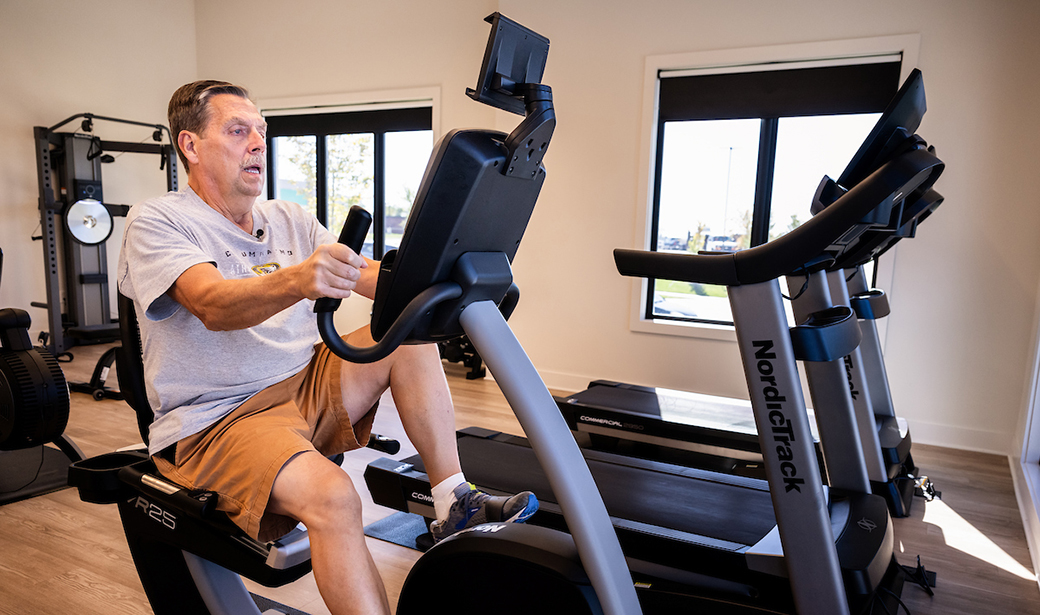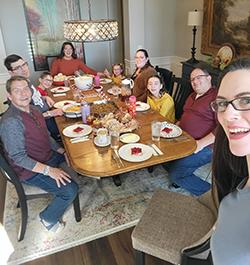The morning Scott Kester had his stroke, he was calm, composed and patient.
Kester, then a certified registered nurse anesthetist (CRNA) at the Missouri Orthopaedic Institute, woke up at the unusual hour of 5:30 on a Sunday morning in early November of 2022 and knew something wasn’t right. Kester had just returned from visiting family, including his wife, in Ohio and was the only one in their condo.
He had severe double vision, but no other symptoms of a medical emergency. He couldn’t drive himself to the hospital safely, so Kester patiently sat and waited in the easy chair in his living room until it was a reasonable hour to call his good friend and coworker Robert Borshesky, DO.
“I described to Rob what was going on, and he said, ‘Scott, you have got to get to the hospital,’” Kester said. “I said, ‘Well, I can't drive like this.’ And he goes, ‘I'll be there in a couple minutes.’ And he drove right over, took me to University Hospital, and the rest is history.”
Kester walked to the front desk and described his severe double vision, but added he was in no pain. As a Comprehensive Stroke Center, MU Health Care has stroke experts on staff around the clock who are able to diagnose and quickly intervene when they see a stroke, even in rare cases like Kester’s.
“Within 10 minutes I was laying on my back in a CT scanner with an IV in my arm and I had been seen by several nurses and a couple of different doctors and it was a flurry for those 10 minutes,” Kester said. “The scan showed I was bleeding in my brainstem and they brought in a neurosurgeon.”
Kester’s neurosurgeon was Farhan Siddiq, MD, an expert in acute stroke and brain bleed, or intracerebral hemorrhage, treatment. Siddiq told Kester he had suffered a hemorrhagic stroke caused by a tangle of unusual blood vessels inside his brain called a cavernous malformation.
“Scott’s stroke was caused by bleeding from this vascular malformation, or abnormal blood vessels in his brain,” Siddiq said. “This happened in his brainstem, a critical area of the brain. It's something we want to be on top of right away and remove as soon as it is safe because otherwise it will progress to a really devastating recurrent bleed with permanent loss of ability.”
The venous malformation in Kester’s brainstem caused a lot of bleeding in an area where surgery is very difficult. His team of doctors, including neurologists, neurosurgeons and neuro intensive care doctors, recommended Kester stay in the hospital under monitoring until they could find out the exact location of the cavernous malformation and remove it.
That night in the hospital, Kester had another bleed and lost his ability to swallow, so surgeons placed breathing and feeding tubes. Siddiq and neurosurgery resident Michael Ortiz, MD, had a difficult task: They needed to know the lesion’s location to operate, which would take time. But if they waited too long, or if Kester’s brain experienced too many re-bleeds, he was at risk of paralysis, permanent intubation and other forms of long-term brain damage.
“His condition was very critical,” Siddiq said. “However, the location is also very critical, and we don't typically like to operate in this location — because the side effects of surgery can be significant — unless we have to.”
Kester’s treatment team discussed the options with Kester and his wife, weighing the pros and cons of operating. Kester clearly remembers that discussion including the potential of long-term brain damage, and the difficulty of recovery that awaited after a successful surgery.
“He stressed that he was going to do the best he could,” Kester said. “But he also said, ‘When you wake up, the recovery is going to be long and tough, and things aren’t going to be as good as they are now.”
For Kester, the decision was an easy one. He wanted to be there for his children and grandchildren and continue living his life with them and for them.
The surgery itself was a technical challenge for Siddiq and his team. Thanks to the multi-specialty approach to stroke care available at MU Health Care, Kester’s doctors had trained to use live ultrasound during the procedure. This technique, developed by doctors here, guided the surgery team exactly where they needed to go to remove the malformation without causing damage to the surrounding brain tissue.
“The area is very difficult to get to and there is obviously high-stakes, valuable brain matter on the way,” Siddiq said. “Treating Scott was unique, and I can confidently say this is one of the most difficult things to do in neurosurgery that a lot of other institutions are not able to offer. We fixed Scott’s issue without causing any new neurologic deficits.”
Coming out of the four-hour procedure, Kester was ahead of where Siddiq hoped he would be, breathing on his own. Because of the timing of his stroke and surgery, Kester spent Thanksgiving in recovery with his wife and granddaughter. But they weren’t alone: Kester’s CRNA friends and coworkers brought over extra food from their break room to help the holiday feel more normal.
Kester’s road back to normalcy included 10 days of occupational and physical therapy at Rusk Rehabilitation Hospital. Before his stroke, his only health concern was high cholesterol, for which he took medication.
Within six months of his stroke, Kester was off that medication by improving his diet and exercising regularly. He remained in Columbia for his many follow-up appointments but used his family back in Ohio for daily motivation. Other than a slight facial droop and double vision in his eyes, Kester is in better health than he was before that frightening, but not frantic, November morning, lifting weights, walking and biking.
“I looked at this as a second opportunity, a chance to start over and make the most of every moment,” Kester said. “I chose to pick up the ball and run as best I could. And the motivating factor behind that is my kids and my grandkids. I want to see them raised. I want to go to their events. I don't want to miss any more. And I was focused on that.”
And unlike Thanksgiving in 2022, spent in the hospital eating through a feeding tube, the Kesters spent 2023 in joyous celebration together.
“I’m grateful for the good care I got from such a great team at MU Health Care,” Kester said. “Dr. Siddiq and the neurosurgery and neurology people to the ICU nurses and respiratory therapy and all the other therapists and nurses, I’m thankful for their skill. I can move my arms and legs, I can walk, hit a golf ball, drive my car, lift weights, ride an exercise bike. I appreciate all of that.”





